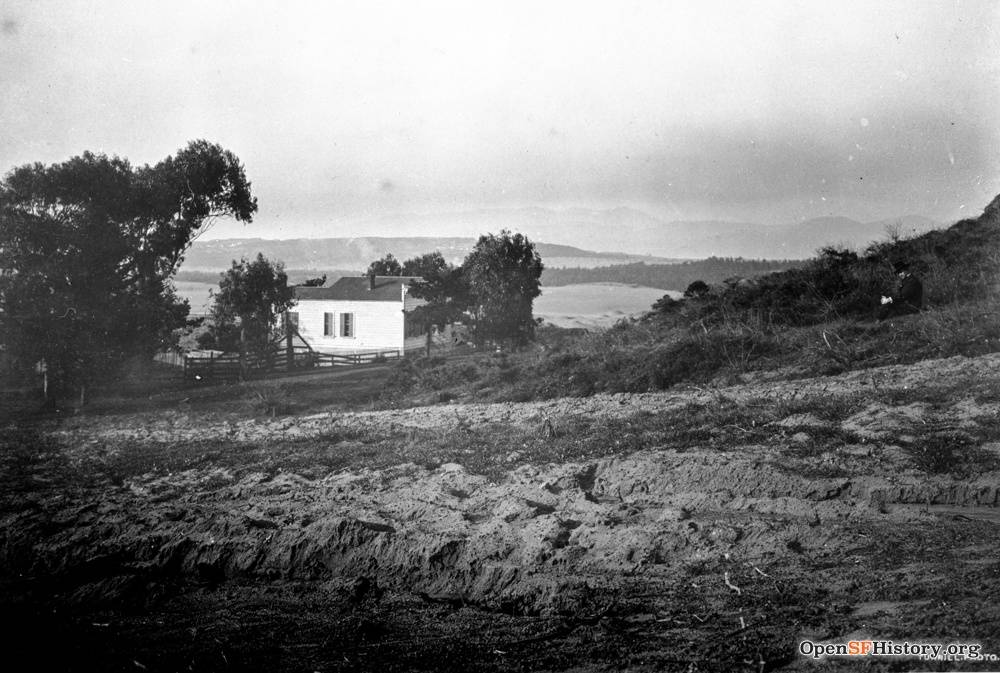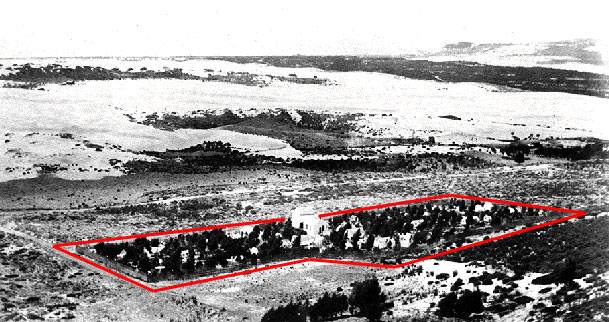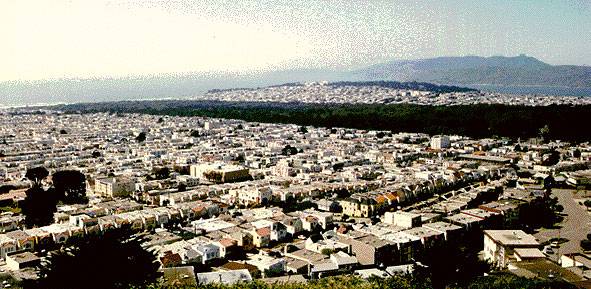Larsen's Chicken Ranch: Difference between revisions
Texteradmin (talk | contribs) No edit summary |
fixed navigation |
||
| (4 intermediate revisions by 3 users not shown) | |||
| Line 3: | Line 3: | ||
''by Mara Ada Williams'' | ''by Mara Ada Williams'' | ||
[[Image: | [[Image:Wnp26.711 19th and moraga house.jpg]] | ||
'''Sunset Ranch House, | '''Sunset Ranch House, 19th and Moraga, with a view north to Golden Gate Park, 1900''' | ||
''Photo: | ''Photo: [http://opensfhistory.org/Display/wnp26.711.jpg OpenSFHistory] / wnp26.711'' | ||
{| style="color: black; background-color: #F5DA81;" | |||
| colspan="2" |'''The Larsen Chicken Ranch stretched for an entire block in the Sunset District and was owned by Carl Larsen, a prominent restaurateur in the city. His Tivoli Cafe was often frequented by local figures and national celebrities as a popular nighttime spot. However, Larsen’s ranch was his most recognizable property, and every Easter Sunday he hosted a festival for his friends and neighbors. There was free beer for his guests, but this generosity was eventually discovered by neighborhood drunks and the ranch often became the location of embarrassing drunken escapades, leading to the end of the festival in 1913. A series of failed property investments followed and Larsen died broke without the ranch that made him such an iconic member of the Sunset community.''' | |||
|} | |||
Larsen's Chicken Ranch took up an entire block, from Moraga to Noriega Streets and from 16th through 17th Avenues. [http://www.outsidelands.org/carl-larsen.php Carl Larsen] was the owner of the chicken ranch and he was also the owner of the famous "Tivoli" Restaurant and Cafe located on Eddy Street on the north side between Powell and Mason Streets. The Tivoli was at that location before the Fire and Earthquake of 1906, and it was open for 24 hours a day. It was one of the casualties of the Fire, but it was rebuilt right after the quake and reopened at that same spot | Larsen's Chicken Ranch took up an entire block, from Moraga to Noriega Streets and from 16th through 17th Avenues. [http://www.outsidelands.org/carl-larsen.php Carl Larsen] was the owner of the chicken ranch and he was also the owner of the famous "Tivoli" Restaurant and Cafe located on Eddy Street on the north side between Powell and Mason Streets. The Tivoli was at that location before the Fire and Earthquake of 1906, and it was open for 24 hours a day. It was one of the casualties of the Fire, but it was rebuilt right after the quake and reopened at that same spot | ||
| Line 17: | Line 21: | ||
From the Stanton home, every morning between 6:30 and 7:00 you could see a small covered wagon, pulled by a tiny brown horse, come rumbling down the hill from the ranch. The wagon was loaded down with fresh eggs, (no chickens), on the way to the Tivoli Cafe. Again at around 4:00 pm each day, that same small covered wagon with its tiny brown horse would labor with great effort to climb the hill, pulling that wagon up 19th Avenue back home to the ranch for a night's rest. | From the Stanton home, every morning between 6:30 and 7:00 you could see a small covered wagon, pulled by a tiny brown horse, come rumbling down the hill from the ranch. The wagon was loaded down with fresh eggs, (no chickens), on the way to the Tivoli Cafe. Again at around 4:00 pm each day, that same small covered wagon with its tiny brown horse would labor with great effort to climb the hill, pulling that wagon up 19th Avenue back home to the ranch for a night's rest. | ||
Every Easter Sunday since before the Earthquake, Carl Larsen would sponsor an Easter Sunday Festival at that Ranch. It was open house for all his friends and neighbors in the Sunset District. The road to the Ranch from 19th Avenue was up Noriega Street. It was a very steep one-way red rock road. You took a left hand turn north on 16th Avenue to enter into the ranch at the middle, right through the main gate. There was no car line on 20th Avenue as yet. Carl Larsen's friends from downtown had to get off the street car at 19th Avenue and Lincoln Way then walk up 19th to get to the [[Ranch|Ranch]]. | Every Easter Sunday since before the Earthquake, Carl Larsen would sponsor an Easter Sunday Festival at that Ranch. It was open house for all his friends and neighbors in the Sunset District. The road to the Ranch from 19th Avenue was up Noriega Street. It was a very steep one-way red rock road. You took a left hand turn north on 16th Avenue to enter into the ranch at the middle, right through the main gate. There was no car line on 20th Avenue as yet. Carl Larsen's friends from downtown had to get off the street car at 19th Avenue and Lincoln Way then walk up 19th to get to the ranch. It was an awesome climb. | ||
[[Image:Larsens-chicken-ranch-on-moraga-ave-nw-view-1898.jpg]] | |||
'''[[Larsen's Chicken Ranch|Larsen's Chicken Ranch]] (red outline) just above today's 19th Avenue, looking northwest from Moraga Avenue, c. 1898.''' | |||
''Photo: Private Collection'' | |||
[[Image:1978-Moraga-NW-view.jpg]] | |||
'''NW View from Moraga Avenue, c. 1978.''' | |||
''Photo: Private Collection'' | |||
[[Image:1996-Moraga-NW-view.jpg]] | |||
'''NW View from Moraga Avenue, c. 1996.''' | |||
''Photo: Chris Carlsson'' | |||
Just at the entrance to the main gate on those festive Easter Sundays, there was a long table on the north side and a 30 foot bar on the south side of the ranch grounds. On that table were platters and platters of hard-boiled eggs, sandwiches and every kind of cake and cookie the kids could wish for. But the Main Event was on the south side of the ground at the bar. | Just at the entrance to the main gate on those festive Easter Sundays, there was a long table on the north side and a 30 foot bar on the south side of the ranch grounds. On that table were platters and platters of hard-boiled eggs, sandwiches and every kind of cake and cookie the kids could wish for. But the Main Event was on the south side of the ground at the bar. | ||
| Line 41: | Line 63: | ||
<hr> | <hr> | ||
[[Image:Tours-food.gif]] [[The First Grab| Continue Food Tour]] | [[Image:Tours-food.gif|link=The First Grab]] [[The First Grab| Continue Food Tour]] | ||
[[ | [[Laguna Honda|Prev. Document]] [[Dunes or Dump?|Next Document]] | ||
[[category:Sunset]] [[category:1890s]] [[category:1900s]] [[category:1910s]] [[category:1920s]] [[category:food]] | [[category:Sunset]] [[category:1890s]] [[category:1900s]] [[category:1910s]] [[category:1920s]] [[category:food]] | ||
Latest revision as of 21:36, 10 September 2020
"I was there..."
by Mara Ada Williams
Sunset Ranch House, 19th and Moraga, with a view north to Golden Gate Park, 1900
Photo: OpenSFHistory / wnp26.711
| The Larsen Chicken Ranch stretched for an entire block in the Sunset District and was owned by Carl Larsen, a prominent restaurateur in the city. His Tivoli Cafe was often frequented by local figures and national celebrities as a popular nighttime spot. However, Larsen’s ranch was his most recognizable property, and every Easter Sunday he hosted a festival for his friends and neighbors. There was free beer for his guests, but this generosity was eventually discovered by neighborhood drunks and the ranch often became the location of embarrassing drunken escapades, leading to the end of the festival in 1913. A series of failed property investments followed and Larsen died broke without the ranch that made him such an iconic member of the Sunset community. |
Larsen's Chicken Ranch took up an entire block, from Moraga to Noriega Streets and from 16th through 17th Avenues. Carl Larsen was the owner of the chicken ranch and he was also the owner of the famous "Tivoli" Restaurant and Cafe located on Eddy Street on the north side between Powell and Mason Streets. The Tivoli was at that location before the Fire and Earthquake of 1906, and it was open for 24 hours a day. It was one of the casualties of the Fire, but it was rebuilt right after the quake and reopened at that same spot
The Tivoli was one of those spots which caught all the crowds late at night when all the shows were over and the theaters cleared out. The Cafe was jammed with characters such as Jim Jeffries, Jack Sharkey, Jack Dempsey, "Strangler" Ed Lewis, Eddie Graney, Jim Corbett, Battling Nelson, Abe Attell. Al Jolson and many other sporting and musical/theatrical show folks and those infamous Barbary Coast folks.
The Stanton Family: lived at 1319 19th Avenue. Theirs was a small cabin built at rear of the lot just after the earthquake. Buck Stanton had bought that lot for $44 in 1904, and it became the best investment he had ever made when their house on Telegraph Hill burned down during the great fire of 1906 There were only a few scattered homes west of 19th Avenue in those days, and they were stretched throughout the sand dunes here and there.
From the Stanton home, every morning between 6:30 and 7:00 you could see a small covered wagon, pulled by a tiny brown horse, come rumbling down the hill from the ranch. The wagon was loaded down with fresh eggs, (no chickens), on the way to the Tivoli Cafe. Again at around 4:00 pm each day, that same small covered wagon with its tiny brown horse would labor with great effort to climb the hill, pulling that wagon up 19th Avenue back home to the ranch for a night's rest.
Every Easter Sunday since before the Earthquake, Carl Larsen would sponsor an Easter Sunday Festival at that Ranch. It was open house for all his friends and neighbors in the Sunset District. The road to the Ranch from 19th Avenue was up Noriega Street. It was a very steep one-way red rock road. You took a left hand turn north on 16th Avenue to enter into the ranch at the middle, right through the main gate. There was no car line on 20th Avenue as yet. Carl Larsen's friends from downtown had to get off the street car at 19th Avenue and Lincoln Way then walk up 19th to get to the ranch. It was an awesome climb.
Larsen's Chicken Ranch (red outline) just above today's 19th Avenue, looking northwest from Moraga Avenue, c. 1898.
Photo: Private Collection
NW View from Moraga Avenue, c. 1978.
Photo: Private Collection
NW View from Moraga Avenue, c. 1996.
Photo: Chris Carlsson
Just at the entrance to the main gate on those festive Easter Sundays, there was a long table on the north side and a 30 foot bar on the south side of the ranch grounds. On that table were platters and platters of hard-boiled eggs, sandwiches and every kind of cake and cookie the kids could wish for. But the Main Event was on the south side of the ground at the bar.
Larsen had his own bartenders doing the serving. They were adorned with their red and blue arm bands just above their elbows and they really looked their part as bartenders, what with those long handled mustaches.
There were always at least 15 to 20 barrels of beer, with three barrels going at once at the bar. Hard liquor was also served. Each barrel of beer held 32 gallons. There was no 3% beer served at these affairs; it was at least 8% or 10%. Everything was free on that day.
Larsen encouraged all his guests to walk up and down the aisle's of the ranch to gaze at the thousands of white leghorn chickens that laid all the Cafe eggs which were served fresh every day. The whole show was a fascinating event and all the friends and neighbors looked forward to celebrating Easter Sunday at Larsen's Chicken Ranch.
But news of the event eventually got out to some unsavory characters. The drunks and winos from all over town started to gather at the gate long before the opening for the Feast. They all made pigs of themselves at the bar. That last Easter Sunday affair, when Larsen realized that he could no longer sponsor this festive event for his friends was in 1913. Around 4:00 pm the road down from 17th Avenue to 19th Avenue was strewn with about six or seven drunks all sprawled out in the middle of the road and in the gutter. Bodies were stretched all the way down to Lincoln Way. It was the most disgusting thing that the neighborhood had ever witnessed. This calamity ended Carl Larsen's generosity.
Poor Larsen was so disturbed over what had happened that day, that he put an ad in the local papers apologizing for the conduct of those few disgusting drunks who had caused all that trouble. The ad also informed everyone that the affair would never be held again.
Carl Larsen moved into the Sunset in the 1890's. He was a smart and frugal man and as fast as he made money at his restaurant he invested it in property. He eventually bought up all of the Larsen Ridge which extended from Lawton Street on the north to about Santiago or Taraval on the south.
When the Twin Peaks Tunnel was built, the new tax assessment rates for folks living west of the tunnel went sky high. It hit poor Larsen like a bomb shell! This tax assessment broke him financially and spiritually. He did manage to work a deal with the City whereby he donated two blocks from Ulloa Street to Wawona Street between 19th and 20th Avenues. But he still did not have enough money to pay off the remainder of the huge tax assessment. He finally died a broken hearted man. Larsen's nearest relative lived on 4th Avenue just past Lincoln Way. When they inherited the Larsen Estate, they did not want anything to do with the restaurant business. The great Tivoli Cafe with all its long ago memories passed on, forever reminiscent of places such as Toots Shorr's in New York's Times Square. In those long ago days, great sportsmen such as Babe Ruth, Jack Dempsey, John McGraw, Ty Cobb and all the immortals gathered in those halls to eat and drink and challenge one another and tell tall tales about their prowess. Those were the days!!
--Mary Ada Williams, North Scale Institute, San Francisco





